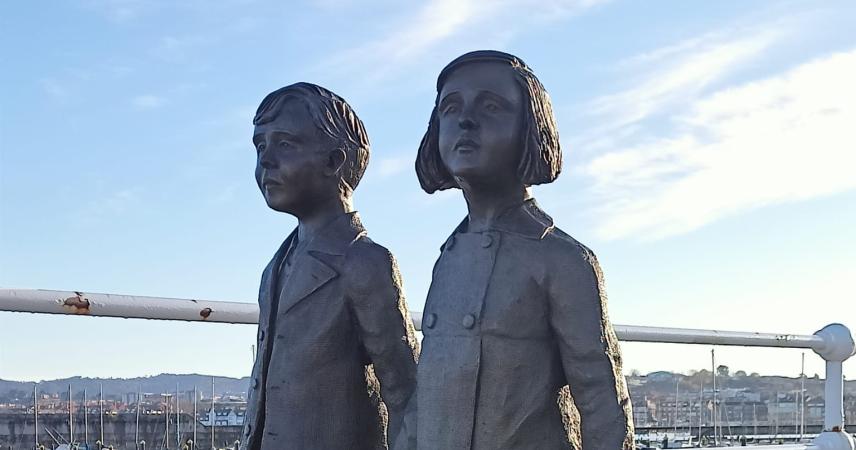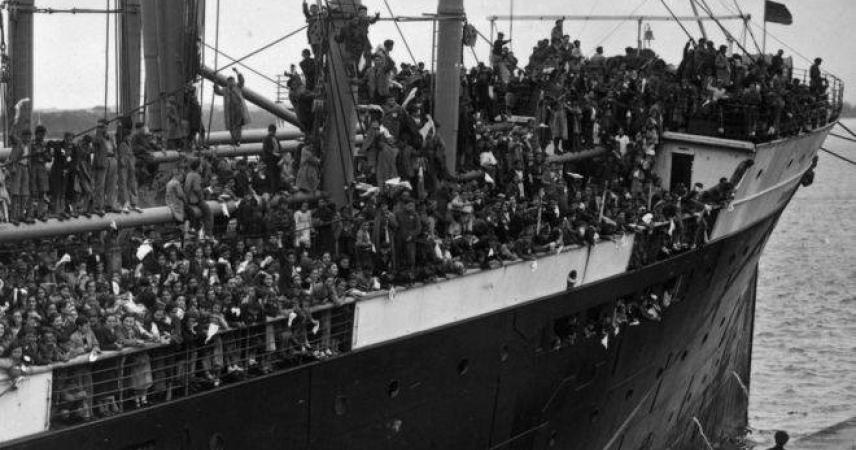The sculptural ensemble representing a boy and a girl before leaving for exile inaugurated on 18th November 2022 in addition to the mosaic, erected in 2006, Santurtzi Municipal Council seeks to keep alive the memory of the Basque refugee children who were shipped out from the Port of Bilbao facilities in Santurtzi to get them away from the horrors of the Civil War. This was the first time that civilians had been evacuated in this way in a war, and most of those involved were children. The ships were organised by the Social Assistance Department of the Basque Government in May and June of 1937, though the sailing on 13 June was arranged by the International Red Cross and the Soviet Communist Party.
As the Francoist troops began their offensive in Bizkaia, many towns and villages were bombed indiscriminately by the Condor Legion, a German air squadron attached to the rebel forces. The consternation that followed the carpet bombing of Gernika on 26 April 1937 was the last straw which led to the organising of a large-scale evacuation of the civilian population. Support from the UK and France was essential in this, as the Francoist navy opposed the project. France undertook to welcome refugees onto its territory and the Royal Navy agreed to escort the evacuation ships. The support of these two powers and the active involvement of the Royal Navy sparked a furious reaction by the Francoist authorities, who saw this as intolerable foreign interference. They even threatened to sink any refugee ships that set sail from the Port of Bilbao (Santurtzi).
The ship used by the Basque Government was the liner Habana, which had already been requisitioned for conversion into a hospital ship. Several merchant vessels flying the Spanish republican, British and French flags also helped evacuate people, as did the Goizeko-Izarra, the private yacht of Basque shipping magnate Ramón de la Sota. The ports to which these ships sailed were Pauillac, near Bordeaux, and La Pallice in La Rochelle, with St Jean de Luz and Bayonne on standby for emergencies.
The main sailings were from Santurtzi, and they carried chiefly but not exclusively children. The first evacuation took place on 6 May 1937, when the Habana set sail for La Rochelle with 2483 refugees on board. On 9 May three French merchant ships (the Carimare, the Châteu-Palmer and the Margaux) which had docked the previous day to bring in several tonnes of food and provisions, set sail back to France with a further 2000 evacuees from well-off families who had paid for their own passage. 21 May saw the only voyage to the UK, when the Habana set sail from Santurtzi carrying 3861 children. With the front moving ever closer to Bilbao, the Habana evacuated 3728 people on 1 June and a further 4251 on 6 June. On 10 and 13 June the Goizeko-Izarra evacuated the 270 children who were in the Sanatorium at Gorliz. The last and biggest sailing was on 13 June, when 4500 children left for La Rochelle on the Habana and 1600 were taken by the French steamer Sontay to the USSR, arriving in Leningrad a week later.
The people of Santurzi also remember the escape of the Republican destroyers Ciscar and José Luis Díez on 15 June. The latter had not been to sea for so long that the locals nicknamed it "Pepe of the Port".
.jpeg)

